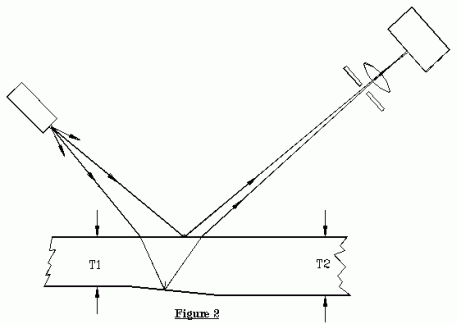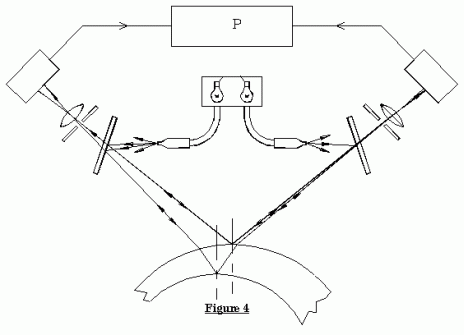|
Non-Contact Measurement Expertise |
|
| Southeastern
Container, Bowling
Green, Ohio General Manager, Jeff Fay, remarks, " The PETWall® gauge, an NCI developed product, has been a great addition to our plant to ensure that we are producing and shipping a quality product. We love the ease and simplicity of the PETWall® system. The PETWall® gauge allows for on-line inspection of every bottle produced." |
|
Non Contact Internationals patented DLLS technology is a new approach for measuring wall thickness and solves many of the problems inherent with laser, vision, mechanical and ultrasonic systems. A
simple optical technique, shown in the diagram below, has been the basic
optical design for measuring wall thickness of transparent objects for
several decades. By reflecting a beam of light from the front and back
surface of the object at some appreciable angle away from the normal, then
measuring the spacing between first surface reflections, provides a
measurement indicative of the distance between the two surfaces.
It
can be seen in diagram 1 that the ray of light which enters the object in
order to reflect off the far surface, will be physically displaced from
the ray which simply reflects off the front surface on it's way to the
detector. The amount of the displacement is directly proportional to the
distance between the two surfaces.
In
this case, the ray that enters the object and then reflects off the back
surface encounters a different incident angle than the ray that reflects
off the front surface, and thus is reflected off at a different angle than
it would be if the two surfaces were parallel. This will move the
reflections closer, or further apart, which is indistinguishable from
changes in thickness. This error is called the prism effect. The prism effect can be partially corrected by using two independent light
sources and detector combinations to gather additional information by
measuring from opposite directions, but then a second type of error,
called parallax, can be introduced. Parallax error results if different
light paths can occur when object variations cause the reflections to
change positions in space. Implementing identical optical and lightings
systems can partially correct for parallax but this requires a very
complex design such as the one shown in figure 4. This solution is costly,
difficult to align and does not completely eliminate parallax. DLLS
technology provides an exact optical correction for the prism and parallax
effects. Like the design shown in figure 4, DLLS uses two optical
measurements at 90 degrees from each other but DLLS patented technology
uses diffuse line light sources that are physically located and designed
in such a way that they do not introduce parallax effects. Beam splitters
and complex optical design is eliminated. Axial variations are corrected
by using lines of diffuse light rather than point sources such as are
typically used in Laser systems.
DLLS
also incorporates an exact mathematical solution to correct for
magnification changes when a part moves about in the field of view during
gauging. Other optical systems on the market today severely restrict part
movement during inspection. DLLS allows significant part movement in the
field if view without compromising measurement accuracy. DLLS capability
is not limited to a single dimension curvature. Conical and or spherical
sections can be measured with little loss in accuracy.
Timken
Company
|


